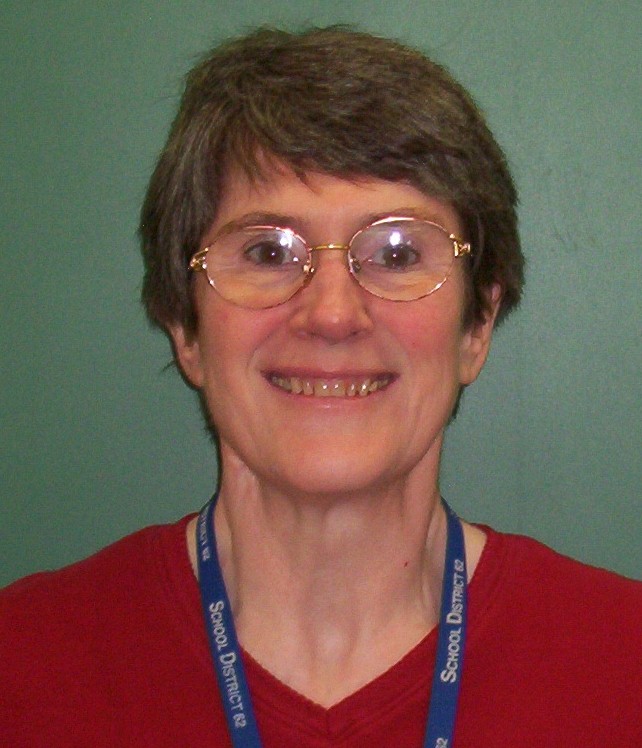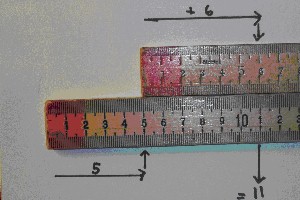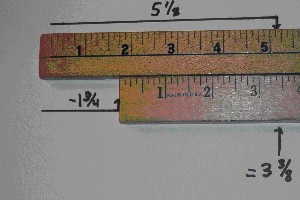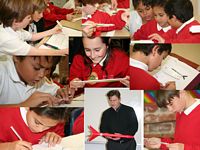|
|

Getting Hooked on Slide Rules – a Classroom Update
Dagmar Rutzen, Des Plaines, Illinois
Each new school year presents new students and new challenges. Of course I wanted again to introduce this group of students to the use of the slide rule. Not one of my students had ever heard of a slide rule. Since I wanted them to be successful right away, I decided to take a different approach in my introduction as to how a slide rule works on a very basic level.
Each student was given two half meter sticks where one side was in inches and the other side was in centimeters. I colored the first couple of centimeters of each half meter stick with a red marker. This way I was able to see at a glance if everyone was on the correct side.
I explained to my students that if we had two identical scales that have even increments, we could add and subtract with our two rulers. We started out with the metric side up on our rulers and laid them next to each other in such a way that both were lying flat on the table and the zero ends matched.
The students were asked to slide the left end of the top ruler to the 5 cm mark of the bottom ruler. It was then explained to them that we now could add 5 to any other number on the top ruler and would find our sum directly below that number on the bottom ruler. We used whole number addends first. The kids caught on quickly and thought it was fun. I told them since they were so good; we now would do the same thing, but use decimals in our addends. The metric side of the rulers lended itself very nicely to this task. They were a little leery at first, but soon got into the spirit of things when they realized how easy it was to do.
The students groaned when I told them we were now going to do their favorite thing and add mixed numbers together. Most of my 7th graders are not fond of fractions or decimals. We used the inches side of the rulers to work with the mixed numbers. It did not take long for them to be able to find the sums of the problems I gave them. They were delighted to not have to find common denominators.
Since the students were so successful with the addition problems, they were eager to do subtraction problems, even with decimals and fractions. To do the subtraction problems, we moved the zero end of the lower ruler to the first number that we wanted to subtract on the upper ruler.
My students were very excited with this simple exercise and are looking forward to using the real slide rules.
Oughtred Society member Dagmar Rutzen teaches seventh grade science at
Algonquin Middle School, Des Plaines, Illinois. Her original article appeared
in the Journal of the Oughtred Society, Vol. 14, No 1, Spring 2004, page 14.
|



|
Slide Rules for Air Navigation and Flight Logistics at IM 2007
Prof. Karl Kleine, Germany
At the very successful IM 2007 at Lelystad and Enkhuisen, about which you can read more in Tom Wyman’s article in this bulletin, I had the pleasure to attend a couple of presentations about slide rules for navigating and planning a trip, both by ship and plane. The location suited perfectly, if you consider history: The places of the conference were an old harbour town (Enkhuisen) and the middle of the former Zuiderzee (Lelystad), the former arm of the North Sea then extending from the northwest coast of the Netherlands to the port of Amsterdam. This was right on the route of the Dutch merchant ships, connecting Amsterdam with all the European harbors and with the Dutch colonies, in particular those in south-east Asia. International trade gave the Netherlands their famous “golden century”. Navigation and logistics are thus natural subjects for a meeting of slide rule collectors in the Netherlands.
Many things changed: The Zuiderzee was closed off from the North Sea in 1932, and much of it was further closed off by dikes and pumped dry, resulting in new land under sea level, the polders. Lelystad is a new town, just incorporated in the 1960's, and now the capital of the new Dutch province Flewoland. Rotterdam is not only the main Dutch harbor today, it is the largest harbor in Europe. Last but not least, ships have been replaced by airplanes not only for passenger traffic, but also for many types of cargo. Schiphol International Airport near Amsterdam is one of the largest and busiest airports of Europe. Things have changed, but navigation and logistics remain key issues.
We had lectures about sea navigation at former IMs, for instance about Gunter rules. This year’s IM programme featured a number of lectures on “going up” and finding your way with an airplane. First to mention are two very lively and enlightening talks by Ronald van Riet about dead reckoning computers in general and about Knemeyer’s “Dreieckrechner” in particular. An airplane pilot has to tackle two tasks: first, he must steer a course such that the actual course over ground matches his intentions, thereby counteracting the wind forces and the resultant drift; second, he has to calculate time and distances from the effective speed over ground which he can achieve with his airplane, where he can only read wind speeds. Today, GPS and electronic devices can take care of all that. Before, there were a number of ingenious devices, mostly circular slide rules, often combined with another instrument for calculating the wind triangle by graphical means. Ron traced back their history from the earliest specimen to the ubiquious E6B and AVIAT models and its variants. This is much too much to write about here, but Ron did not only give a wonderful talk, but also wrote a fine piece of documentation for the conference proceedings, with lots of illustrations. The same holds for a particular series of dead reckoning computers, the “Dreiecksrechner” by Knemeyer and their descendants, the ARISTO AVIAT models, all manufactured by Dennert & Pape.
Siegfried Knemeyer and his life were an enigma for a long time, and many facets of his life and work will most probably remain so. Huib Ottens was able to shed some light on Knemeyer’s life and career, depicting a compulsive pilot, an aircraft visionary and a gifted engineer. Knemeyer’s personality is difficult, to say the least; he did engage with the Nazi regime just in order to realize his visions of airplanes and flying. This eventually led him to the position as head of technical development of the German Ministry for Aviation in 1943. He was responsible for some of the most advanced designs of these days. His famous “Dreiecksrechner” was a relatively early work, done already before and in 1936. After WWII Knemeyer went to the USA and became a consultant for the US Air Force.
The third speaker to mention is Robert Bargl. Whereas the former two are a slide rule collector and an aviation hobby historian, Mr. Bargl was a flight engineer at Lufthansa, with a long career starting in the fifties with transatlantic flights (you remember the Lockheed Super Constellation?), progressing to the jet era, finally the Boeing 747 models, and ending as Lufthansa’s chief flight engineer. He devised a family of special slide rules for fuel management. The oil crisis of the 1970's hit the aviation industry hard. From 1970 to 1981 the fuel prices rose by 1600%! As a reaction Robert Bargl designed the special circular slide rule and had it fabricated for Lufthansa by Riehle. This slide rule actually saved Lufthansa 180 million Deutschmarks in the three years from 1983 to 1985! Now, this is a figure to remember when you talk about the value of a slide rule. Mr. Bargl illustrated the use of the rule by a sample flight from San Francisco to Frankfurt, demonstrating the economic issues of such a trip: effects of flight altitude, optimum and legal altitudes, and what ground control can do to you in missing economical goals, the phases of ascent, cruise and descent, and where and how you can save fuel. It was most instructive, and gave the audience a totally different view from the usual view of a flight as an aircraft passenger. By now you will have guessed it: Mr. Bargl’s “B747 performance calculator” circular slide rule is now on board of every Lufthansa Jumbo Jet lifting off, along with a modern version of the AVIAT (you never know when you might need that).
These four presentations of aircraft slide rules were complemented by two more general ones about navigation issues, a talk by Otto van Poelje about time-speed-distance calculators, a task universally popping up in navigation, and a talk of personal recollections by Peter Soole about his professional life at Blundell Harling on slide rules and navigational instruments. Alex Green could not come to read his paper about his work with slide rules in WWII, which you can find in the proceedings (you might also check JOS, vol 9 no 1, spring 2000); IJzebrand Schuitema provided some personal recollections about Alex Green instead.
It was a great pleasure to listen to these presentations and watch the exquisite slide shows with many pictures of the items discussed, in particular to Ronald van Riet and Robert Bargl, two real aviators sharing their enthusiasm and experience with the IM audience.
You should definitely get the proceedings! Please see the announcement of the CDROM by Otto van Poelje in this bulletin. Otherwise look at www.rekenlinialen.org. The CD not only contains the proceedings as a PDF file, but also the presentations, and lots of pictures.
|

|
Slide Rule Loan Program
Mike Konshak, Louisville, Colorado
The most recent benificiaries of the International Slide Rule Museum's Slide Rule Loan program are the students participating in the Delta V program at St. Vincent de Paul Elementary School in Petaluma, California. Slide rules are being used to calculate the characteristics of model rockets prior to an actual launch. The program teaches both the math and the science around rocketry. There are several excellent lectures and tutorials created by Dick Herman, the instructer and mentor for the Delta V program. Take time to visit their website.
If you are an educator, or know an educator, wishing to give your students a hands-on experience with actual slide rules, Mike Konshak, curator of the on-line International Slide Rule Museum will supply quantities of up to 25 matching slide rules for temporary use, free of charge, courtesy of several collectors.
Requests on school letterheads must be received in order for the slide rules to be shipped. The school will be responsible for return postage and safe return of the slide rules in the time period requested.
Contact Mike Konshak : Evenings: 303-673-9853, Days: 303-272-4175, Cell: 303-921-8709, or email: curator “at” sliderulemuseum.com
If you are a collector who wishes to participate in this program by furnishing slide rules for loan, please let us know. We are looking for more international contacts. We currently have slide rules in the USA and Australia available for loan.
|


Slide Rule Math and Rocket Course

St. Vincent de Paul Students
|
New Slide Rule Book: K+E Salisbury Products Division Slide Rules
Editors
The new book K&E Salisbury Products Division Slide Rules by Joe Soper is now available from The Oughtred Society, printed in 2007.
Joe’s 29 years with K+E, including those as manager of the Salisbury Products Plant, provides us a unique opportunity to learn from his experiences.
This book is a story told by Joe Soper as if he were sitting in your living room talking with you. The story is packed with human interest while providing many fascinating details of slide rule production at the Salisbury plant. There is something for everybody. How plastic slide rules were made by K&E is the main theme but along the way there are many details about how the scales were laid out, how the molding masters were made and many other production details. The bizarre story of the Analon is finally told by someone who was there. How K&E managed the design and introduction of a new major slide rule (the Deci-Lon) is told. The book contains details of K&E history which have not been written before.
Even if you are not a K&E enthusiast, this book will provide much valuable information and answers to many of your questions.
Size : 8½” X 11”. 145 pages. Soft cover. Contains 102 photos, many in color. Price : $39.00 plus shipping. Visit www.oughtred.org to order.
|

|
Slide Rule Tips, Tricks, Shortcuts and Clever Methods
Gary Flom, Stockbridge, Georgia
Finding the three cube roots of 8.
We know the real cube root is 2, but what are the two complex cube roots of 8?
Think of an equilateral triangle ( T ) centered at the origin with one vertex of T at the point ( 2,0 ) . If we compute the coordinates of the other two vertices, we will be finding the two complex cube roots of 8.
Let's find the " top left " vertex of T . Call this point Cr1.
If you sketch this, you can see that you form a 30-60-90 triangle
with the vertices as : the origin, Cr1, and
the point where T intersects the ( negative ) "x" axis.
To get the x coordinate of Cr1, solve : x / 2 = cos 60 degrees.
We find x = 1 . Since Cr1 is in the quadrant where x is neg
(and y is pos) , we write this as : -1.
To get the y coordinate of Cr1, solve : y / 2 = sin 60 degrees.
We find y = 1.73 .
Now, we may write a complex cube root of 8 using this x and y,
with the y being the imaginary part of the root.
That is :
cb rt of 8 = -1 + 1.73i .
And by symmetry, which is apparent
by our graph, the other complex cb rt of 8 is :
-1 - 1.73i since the other vertex of T has the coordinates ( -1 , -1.73 )
|

|
|
|
|